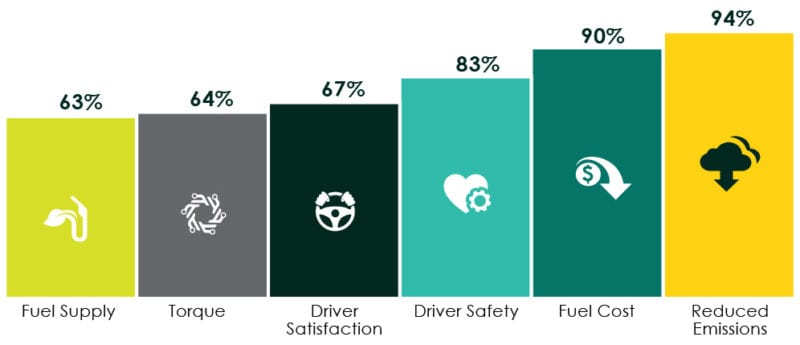In partnership with: Trillium

Even with 2020 being an extreme outlier year, the growth of both natural gas fuel and natural gas vehicles (NGVs) showed no sign of slowing. As confirmed by the latest independent industry report, the State of Sustainable Fleets, and backed up by hundreds of survey responses from real-world fleets across the U.S., NGVs continue to demonstrate both superior environmental and economic performance — even when measured against gasoline and diesel.
The notion that significant emission reductions can be accomplished only by sacrificing vehicle performance or paying more for clean fuels does not hold true. This year’s findings confirm that when mature clean vehicle technologies, including natural gas, are matched to the best-equipped sectors for those technologies, fleets really can have it all.
Hundreds of survey responses from real-world fleets demonstrate the superior environmental and economic performance of NGVs.
Sectors Driving Natural Gas Growth
In 2020, three sectors — refuse, transit and dedicated heavy-duty fleets — continued to drive natural gas growth. The transit and refuse markets specifically accounted for just under half of all NGV deliveries in 2020.
With natural gas technology best-fit to their operations, these sectors are realizing a host of benefits by fueling with natural gas, including fuel cost savings, emissions reductions, reduced maintenance costs and lower overall total cost of ownership. Currently, no other commercially available zero-emission technology can provide comparable benefits, making natural gas the preferred clean vehicle option for these hardworking sectors.
An Operational Best-Fit for Natural Gas
A few operational factors work in these sectors’ favor, helping to make them a great fit for natural gas. Vehicles with especially long asset lives, such as refuse trucks and transit buses, can experience high diesel maintenance costs as the vehicles age. Fueling with natural gas allows these fleets to cut maintenance costs in the second half of a vehicle’s life, when the costs to maintain an aging diesel fleet can become prohibitively expensive.
Three sectors — refuse, transit and dedicated heavy-duty fleets — are realizing a host of benefits by fueling with natural gas.
Additionally, these sectors run fixed, predictable routes that allow for plenty of efficient natural gas fueling options. NGVs can fuel either in depots or at designated public stations along their daily routes, while their return-to-base operations allow for the ability to use cost-effective time-fill fueling overnight.
With more than 100 models available from the nation’s most trusted vehicles manufacturers, NGVs are a proven vehicle technology that is both road-tested and commercially available today.
Emissions Reductions Where it Matters Most
When surveyed, hundreds of fleets ranked emission reductions as the top benefit realized from deploying NGVs, with the second being fuel cost savings.
Fleets Realized Equal or Better Performance on these Factors Compared to Diesel

Source: Percent of surveyed early adopter fleets that have either piloted or purchased CNG vehicles who cite a criterion as equal/better or a challenge from the State of Sustainable Fleets 2021 survey.
With ambitious corporate sustainability commitments growing in scale, and emission reductions mandated at the local and state level, the ability to reduce emission remained a top fleet priority in 2020. NGVs produce tailpipe emissions that are so low, they are nearly undetectable. The most harmful emissions, those that impact human health and the environment, are so low that they are referred to as near zero emission. Certified near-zero-emission NGVs are 90% cleaner than the EPA’s current heavy-duty NOx emission standard.
When vehicles operate along city streets and throughout neighborhoods, the capability to nearly eliminate tailpipe emissions becomes not just a “nice to have,” but a “must have.” NGVs can do this immediately and at scale starting today.
RNG’s growing reputation as an ultra-low-emission, carbon-negative replacement for fossil CNG is gaining momentum.
RNG: The Only Climate-Positive Fuel Available
While NGVs already produce tailpipe emissions that are nearly indetectable, in many parts of the country the carbon content of renewable natural gas (RNG) — natural gas sourced from organic waste streams — is decreasing. RNG’s growing reputation as an ultra-low-emission, carbon-negative, drop-in replacement for fossil CNG is gaining momentum with fleets across the country. Nearly 90% of surveyed fleets currently operating NGVs state they intend to use RNG in the next year.
RNG provides the greatest GHG emission-reduction benefits compared to other renewable technologies and continues to displace fleet adoption of fossil-sourced CNG. The 2021 report also found that RNG use in on-road transportation increased in California from 69% in 2018 to 93% of total volume in 2020 — a more than 225% increase from 2015. In the fourth quarter of 2020, RNG grew to 98% of all natural gas used as a transportation fuel in California. While California is the epicenter of RNG, this ultra-low carbon renewable fuel is produced at approximately 150 sites in 29 states across the country.
This trend is expected to continue in 2021 and beyond, with fleets seeing even greater emission reduction potential from RNG.
RNG provides the greatest GHG emission-reduction benefits compared to other renewable technologies.
Leading Fleets Look to Natural Gas
Over the course of 2020, NGVs saw strong sales growth that is expected to continue, due in large part to major orders from some of the nation’s largest fleets. These leading fleets are ordering and taking delivery of NGVs in the thousands — with plans to continue to grow these deployments as well as their use of natural gas and RNG. Driven by ambitious public sustainability commitments, as well as proven cost-savings from natural gas, the nation’s largest and most demanding fleets are continuing to invest in and deploy NGVs with confidence.
Starting Out with Natural Gas
For fleets looking to decrease emissions and save money on fuel costs by deploying NGVs, first begin by evaluating your fleet’s operations by examining factors including daily range, fueling needs and special duty cycle needs. Higher mileage, high fuel consumption vehicles are always a great fit for natural gas and can ensure an even faster payback on vehicle investment.
The State of Sustainable Fleets’ fleet-focused Natural Gas Mini Guide can help break down the steps required to deploy and scale NGVs in your fleet.
To learn more about Trillium’s portfolio of fueling solutions visit www.loves.com/trillium or reach out to the Trillium team at contact@trilliumcng.com


